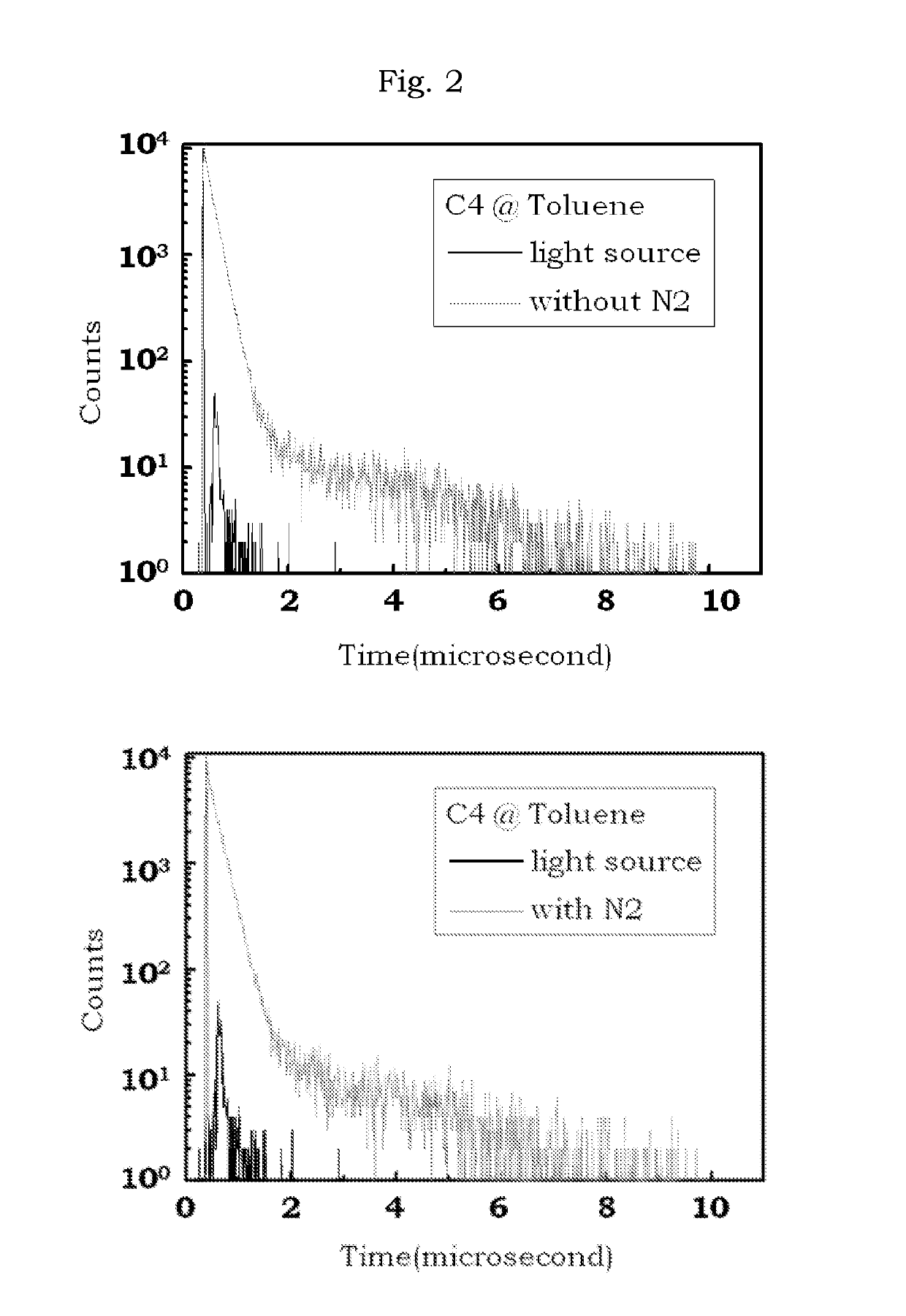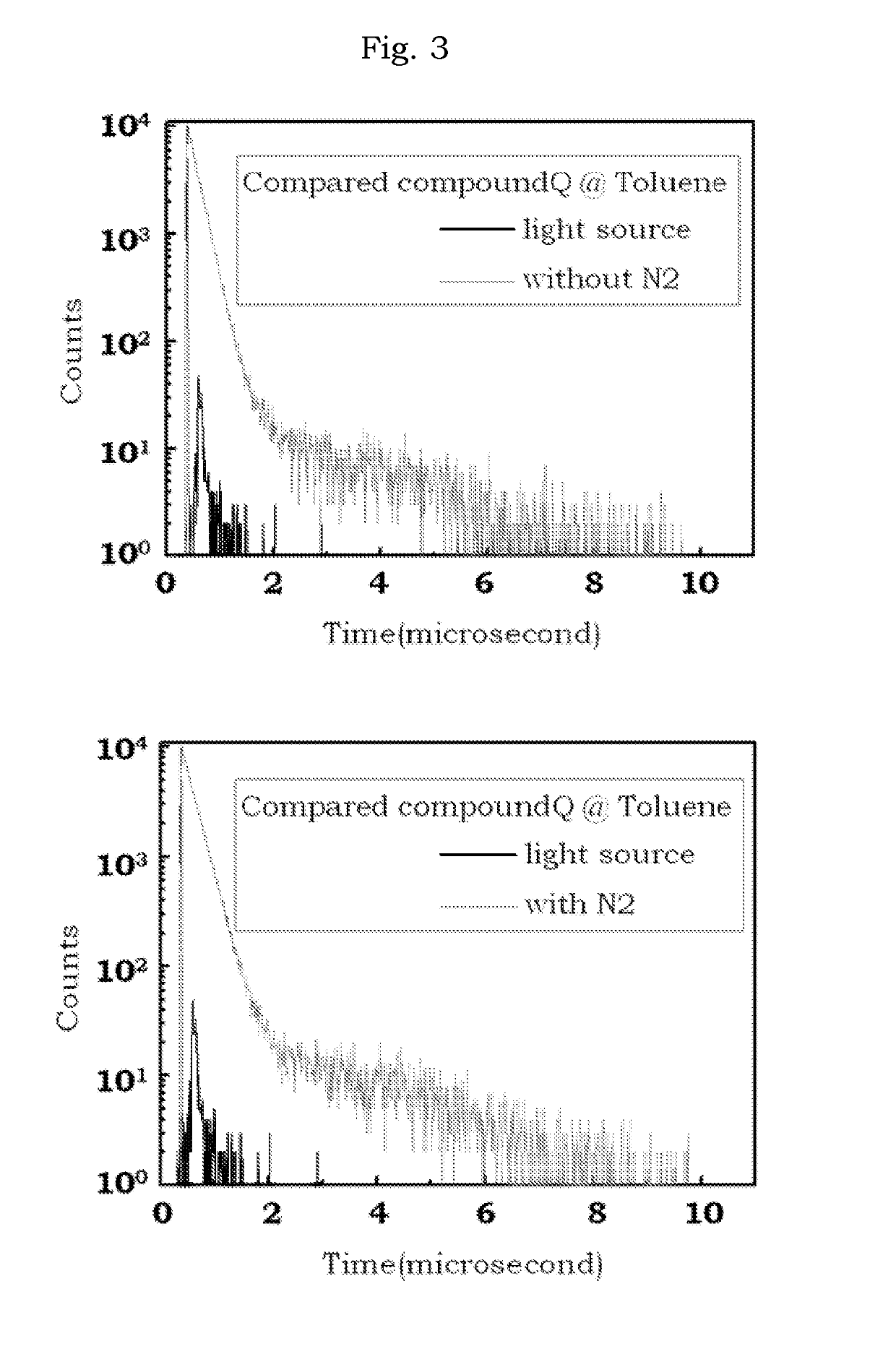Delayed fluorescence compound for organic EL device and using the same
a fluorescence compound and organic el technology, applied in organic chemistry, organic semiconductor devices, luminescent compositions, etc., can solve the problems of unsatisfactory efficiency and driving voltage for industrial practice use, only 25% internal quantum efficiency of fluorescence electroluminescent devices, and unsatisfactory half-life of phosphorescent hosts used for emitting layers, etc., to achieve excellent thermal stability, long half-life time, and high luminance efficiency
- Summary
- Abstract
- Description
- Claims
- Application Information
AI Technical Summary
Benefits of technology
Problems solved by technology
Method used
Image
Examples
example 1
Synthesis of C4
Synthesis of 5,8-dibromo-2,3-diphenylpyrido[3,4-b]pyrazine
[0028]
[0029]A mixture of 10 g (37.5 mmol) of 2,5-dibromopyridine-3,4-diamine and 8.66 g (41.2 mmol) of benzil, 200 ml of acetic acid was heated at 100° C. for 2 h. The resulting mixture was allowed to cool to room temperature, and then filtered to get the yellow solid, yield (11 g, 66.7%). 1H NMR (CDCl3, 400 MHz): chemical shift (ppm) 8.50 (s, 1H), 7.41-7.51 (m, 10H).
Synthesis of 9,9′-(2,3-diphenylpyrido[3,4-b]pyrazine-5,8-diyl)bis(9H-carbazole) (C4)
[0030]
[0031]A mixture of 5 g (11.3 mmol) of 5,8-dibromo-2,3-diphenylpyrido [3,4-b]pyrazine and 5.69 g (34 mmol) of carbazole, 2.16 g (11.3 mmol) of CuI, 7.39 g (22.6 mmol) of Cs2CO3, 2.27 g (8.6 mmol) of 18-crown-6 and 80 ml 1,2-dichlorobenzene was degassed and placed under nitrogen, and then heated to refluex for 12 h. After finishing the reaction, the mixture was allowed to cool to room temperature. The 250 mL of methanol was added, then filtered and washed by met...
example 2
Synthesis of C8
[0032]Synthesis of 9,9′-(3,3′-(2,3-diphenylpyrido[3,4-b]pyrazine-5,8-diyl)bis(3,1-phenylene))bis(9H-carbazole) (C8)
[0033]
[0034]A mixture of 5 g (11.3 mmol) of 5,8-dibromo-2,3-diphenylpyrido [3,4-b]pyrazine and 7.16 g (24.9 mmol) of 3-(9H-carbazol-9-yl) phenylboronic acid, 0.13 g (0.11 mmol) of Pd(PPh3)4, 14.1 ml of 2M Na2CO3(aq), 50 ml of EtOH and 150 ml toluene was degassed and placed under nitrogen, and then heated at 100° C. for 12 h. After finishing the reaction, the mixture was allowed to cool to room temperature. The 250 mL of methanol was added, then filtered and washed by methanol to get the red solid, yield (5.04 g, 59%). MS (m / z , EI+): 765.5
example 3
Synthesis of C17
Synthesis of 9,9′,9″,9′″-(5,5′-(2,3-diphenylpyrido[3,4-b]pyrazine-5,8-diyl)bis(benzene-5,3,1-triyl))tetrakis(9H-carbazole) (C17)
[0035]
[0036]9,9′-(5-(4,4,5,5-tetramethyl-1,3,2-dioxaborolan-2-yl)-1,3-phenylene)bis(9H-carbazole) instead of 3-(9H-carbazol-9-yl) phenyl-boronic acid, except for using the same method as in synthesis Example 2, the desired compound of 9,9′,9″,9′″-(5,5′-(2,3-diphenylpyrido[3,4-b]pyrazine-5,8-diyl)bis (benzene-5,3,1-triyl))tetrakis(9H-carbazole) (C17) was obtained. MS (m / z, EI+): 1096.4
PUM
| Property | Measurement | Unit |
|---|---|---|
| triplet energy | aaaaa | aaaaa |
| internal quantum efficiency | aaaaa | aaaaa |
| internal quantum efficiency | aaaaa | aaaaa |
Abstract
Description
Claims
Application Information
 Login to View More
Login to View More - R&D
- Intellectual Property
- Life Sciences
- Materials
- Tech Scout
- Unparalleled Data Quality
- Higher Quality Content
- 60% Fewer Hallucinations
Browse by: Latest US Patents, China's latest patents, Technical Efficacy Thesaurus, Application Domain, Technology Topic, Popular Technical Reports.
© 2025 PatSnap. All rights reserved.Legal|Privacy policy|Modern Slavery Act Transparency Statement|Sitemap|About US| Contact US: help@patsnap.com



